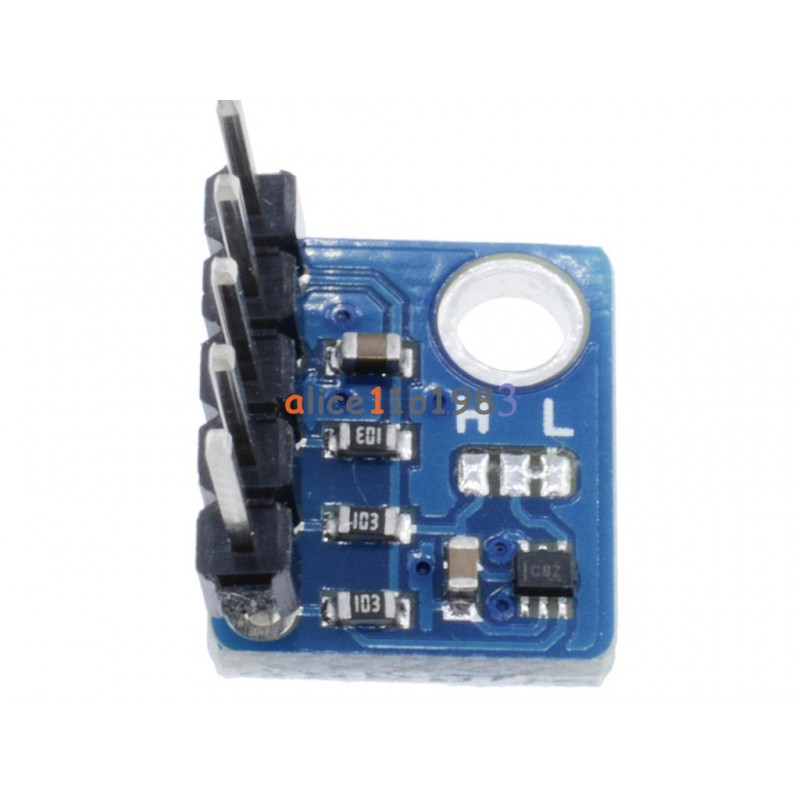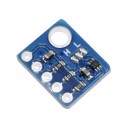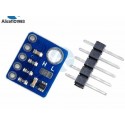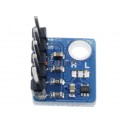Tmp102 Digital Temperature Sensor Module
Rs. 104.00 Rs. 125.00
- Brand: https://www.ti.com/product/TMP102
- Product Code: SEN-TEMP
- Availability: In Stock
- Price in reward points: 3
- For Bulk Order
 9962060070
9962060070
- The TMP102 device is a digital temperature sensor ideal for NTC/PTC thermistor replacement where high accuracy is required. The device offers an accuracy of ±0.5°C without requiring calibration or external component signal conditioning. Device temperature sensors are highly linear and do not require complex calculations or lookup tables to derive the temperature. The on-chip 12-bit ADC offers resolutions down to 0.0625°C. The module (HCMODU0100) provides header pins for power (3.3V), and to its digital I2C interface including bus pullup resistors.
-Accuracy Without Calibration:
-2.0°C (max) from –25°C to 85°C
-3.0°C (max) from –40°C to 125°C
-Low Quiescent Current:
-10-μA Active (max)
-1-μA Shutdown (max)
-Supply Range: 1.4 to 3.6 V
-Resolution: 12 Bits
-Digital Output: I2C interface Compatibility
SPECIFICATIONS:
-Uses the I2C interface
-12-bit, 0.0625°C resolution
-Typical temperature accuracy of ±0.5°C
-3.3V sensor
-Supports up to four TMP102 sensors on the I2C bus at a time
OVERVIEW:
The TMP102 device is a digital temperature sensor ideal for NTC/PTC thermistor replacement where high accuracy is required. The device offers an accuracy of ±0.5°C without requiring calibration or external component signal conditioning.
PACKAGE INCLUDES:
1 PCS x Tmp102 Digital Temperature Sensor Module
https://www.ti.com/product/TMP102
//SOURCE CODE TAKEN FROM BELOW LINK
//http://arduinolearning.com/amp/code/arduino-and-tmp102-digital-sensor-example.php
#include "Wire.h"
#define TMP102_I2C_ADDRESS 72 /* This is the I2C address for our chip. This value is correct if you tie the ADD0 pin to ground. See the datasheet for some other values. */
void setup()
{
Wire.begin(); // start the I2C library
Serial.begin(115200); //Start serial communication at 115200 baud
}
void loop()
{
getTemp102();
delay(5000); //wait 5 seconds before printing our next set of readings.
}
void getTemp102()
{
byte firstbyte, secondbyte; //these are the bytes we read from the TMP102 temperature registers
int val; /* an int is capable of storing two bytes, this is where we "chuck" the two bytes together. */
float convertedtemp; /* We then need to multiply our two bytes by a scaling factor, mentioned in the datasheet. */
float correctedtemp;
/* Reset the register pointer (by default it is ready to read temperatures)
You can alter it to a writeable register and alter some of the configuration -
the sensor is capable of alerting you if the temperature is above or below a specified threshold. */
Wire.beginTransmission(TMP102_I2C_ADDRESS); //Say hi to the sensor.
Wire.write(0x00);
Wire.endTransmission();
Wire.requestFrom(TMP102_I2C_ADDRESS, 2);
Wire.endTransmission();
firstbyte = (Wire.read());
/*read the TMP102 datasheet - here we read one byte from
each of the temperature registers on the TMP102*/
secondbyte = (Wire.read());
/*The first byte contains the most significant bits, and
the second the less significant */
val = firstbyte;
if ((firstbyte & 0x80) > 0)
{
val |= 0x0F00;
}
val <<= 4;
/* MSB */
val |= (secondbyte >> 4);
/* LSB is ORed into the second 4 bits of our byte.
Bitwise maths is a bit funky, but there's a good tutorial on the playground*/
convertedtemp = val*0.0625;
correctedtemp = convertedtemp - 5;
/* See the above note on overreading */
Serial.print("firstbyte is ");
Serial.print("\t");
Serial.println(firstbyte, BIN);
Serial.print("secondbyte is ");
Serial.print("\t");
Serial.println(secondbyte, BIN);
Serial.print("Concatenated byte is ");
Serial.print("\t");
Serial.println(val, BIN);
Serial.print("Converted temp is ");
Serial.print("\t");
Serial.println(val*0.0625);
Serial.print("Corrected temp is ");
Serial.print("\t");
Serial.println(correctedtemp);
Serial.println();
}
15 DAYS




